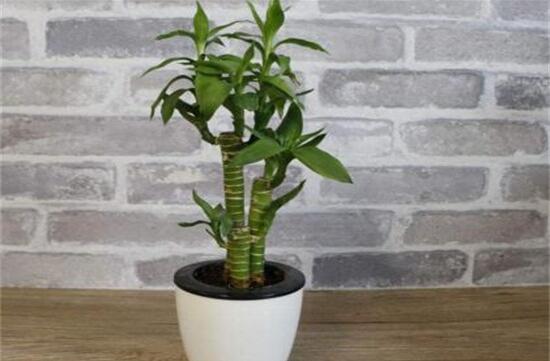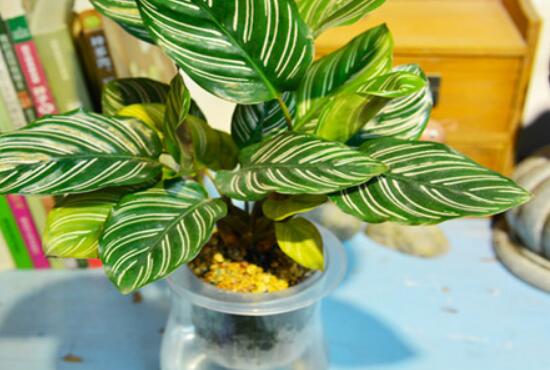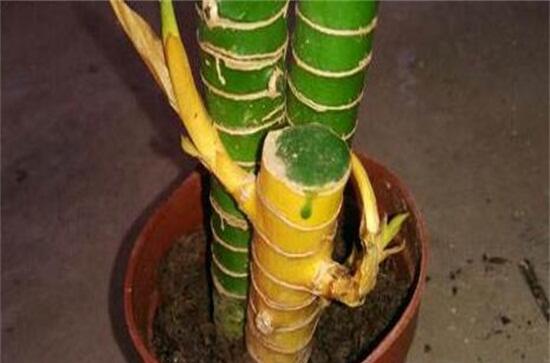How to raise lotus bamboo, culture methods and matters needing attention / like astigmatism exposure
For lotus bamboo, flower friends should be no stranger, it is thick and long, evergreen all the year round, stem straight and elegant, chic posture, is a beautiful ornamental plant. In life, after discovering lotus bamboo, many friends want to raise it, so how to raise lotus bamboo? The following is the lotus bamboo culture methods and matters needing attention, very detailed, friends who want to raise must have a look.
First, how to raise lotus bamboo and understand its habits

Lotus bamboo warm, humid environment, it likes semi-shade, avoid strong light, not cold, afraid of stagnant water, so how to raise lotus bamboo? When breeding indoors, we should put it in an environment with sufficient astigmatism, keep the basin soil moist every day, and take good measures to keep warm in winter. As for the cultivated soil, lotus bamboo is not strict with the soil, and its drainage is good.
2. Culture methods and matters needing attention of lotus bamboo
1. Soil
How to raise lotus bamboo indoors? The editor suggested that we should re-choose the potted soil. Because the lotus bamboo potted plants bought by the online merchandise shop can be maintained normally, but the soil is very cheap. If you want to raise it well, you'd better choose the soil again.
Soil selection: although lotus bamboo does not have high requirements for soil, it grows better in sandy loam soil with wet shade and good drainage. In this regard, the editor recommends that people use rotten leaf soil mixed with river sand or slag ash.
2. Lighting
In the cultivation of lotus bamboo, light is very important, but it likes a semi-overcast environment and can be placed in a place with plenty of astigmatism during family care, such as under the south window or on the balcony.
Note: Lotus bamboo avoid bright light, in summer, it should be moved to a place with a shading rate of 50% to 70%. Once exposed to strong light, there will be some phenomena such as yellowing and discoloration of lotus bamboo leaves, which seriously affect the ornamental ability of the plant.
3. Temperature
How to raise lotus bamboo? Timely adjustment of temperature is also critical. It is understood that the most suitable growth temperature of lotus bamboo is 20-28 ℃. If its leaves are evergreen all the year round, it is best to maintain this temperature when cultured indoors.
Note: Lotus bamboo is not cold-resistant, although it can withstand 2Mel 3 ℃ low temperature, but in winter, if you want it to continue to grow, you should adjust the room temperature to more than 5 ℃.
4. Watering
Water is the source of life, so watering is a very important part of the culture method of lotus bamboo. Because the lotus bamboo likes a wet environment, it is found that some of the potted soil surface is dry and watered during the May-September growing season. In order to ensure the wetness of the basin soil, we should rather be wet than dry when watering, but do not accumulate water or it is easy to rot the roots.
Note: in addition to normal watering, in high temperature in summer, you should often spray leaves and the ground with water to increase air humidity; in winter, you can wait for the basin soil surface to dry in the depths of 2cm before watering; there is not too much watering, otherwise stagnant water will lead to rotten roots of the plant.
5. Fertilization
After watering, let's talk about fertilization, which is also very important in the growth process of lotus bamboo. However, lotus bamboo does not have high requirements for fertilizer. in addition to adding certain mature organic fertilizer as base fertilizer when changing pots, liquid fertilizer can be applied twice a month during the growing period, so that the leaves can be dark green and green, and fertilization should be stopped in winter.
6. Diseases and insect pests
In the process of breeding lotus bamboo, the plant will inevitably get sick because of poor environment, improper maintenance and other reasons. Among them, it is noted that there are thrips and shell insects, and the main diseases are leaf spot, stem rot and root rot, which will endanger the health and beauty of the plant. Therefore, as soon as it is found, we should immediately spray control, specific spray what medicine can refer to lotus bamboo pest control.
Generally speaking, the lotus bamboo is quite easy to raise, but if you want to make it look good, you need to pay more attention and take care of it in accordance with the above requirements, so that it can grow incomparably beautiful. With regard to the culture methods and matters needing attention of lotus bamboo, this is the end of the editor's introduction. Passionate flower friends might as well raise and see.
How to cultivate lotus bamboo culture methods and matters needing attention
As we all know, raising flowers and plants is not only beautiful but also self-cultivation, many people like to raise some green plants that are easy to breed and beautiful at home. Lotus bamboo is one of our favorite plants farmed at home, not only easy to raise and beautiful and generous, can purify the air, at the same time, it represents wealth and auspiciousness, rising, deeply sought after by everyone. So how to cultivate lotus bamboo?
How to raise lotus bamboo
The dragon blood tree of the family Liliaceae is an evergreen erect shrub, which is very suitable for indoor water-raised lotus bamboo. The leaves of Fugui bamboo are green, the stems are straight and round like bamboo. Leaves ovate, apex pointed, petiole base clasping. It is a very shade-tolerant plant. It still grows well and is tall and strong under weak light conditions. Can be placed indoors for a long time to watch the leaves, do not need special maintenance, as long as there is enough water, it can grow vigorously. When hydroponic culture, the rich bamboo stem will be cut into small segments of more than 20 cm as cuttings in water, as long as the cuttings can be soaked in water, they can take root and survive.
For plants that like warm, moist and scattered light, sandy loam soil with good drainage and shade is the most suitable. For fear of stagnant water, the most suitable growth temperature is 22Mel 30 ℃.
Culture method of lotus bamboo
1. Soil
It is suitable for growing in sandy soil or semi-muddy sand and alluvial clay with good drainage.
2. Watering
During the peak growth period from May to September, we should water more, keep the soil moist, rather wet than dry, but do not accumulate water or it is easy to rot the roots. High temperature period should also often use water to spray leaves and the ground, increase air humidity, and appropriately reduce the amount of water in autumn and winter.
3. Fertilization
During the growth of lotus bamboo, liquid fertilizer is applied twice a month, which can make the leaves green and green, and stop applying fertilizer in winter.
Lotus bamboo has strong adaptability and can grow well in full light, half light and shade. Like the environment of high temperature, high humidity and plenty of sunshine. Like sandy soil, avoid stagnant water, drought resistance.
4. Light and temperature
The suitable growth temperature is 20 ℃ and 28 ℃, which can withstand the low temperature of 2 Mel and 3 Mel, but it should be frost-proof in winter. The hot and humid season in summer and autumn is very beneficial to the growth of lotus bamboo, and it is the best time for its growth. It is not strict with light, so it is suitable to grow under bright scattered light. Excessive light and sun exposure will cause leaves to turn yellow, fade green, grow slowly and so on.
5. Methods of reproduction
Cut the truncated stem into 5 cm to 10 cm leafless stem nodes in spring, or the basal tip is easy to dry up. Long-term in the indoor shade part of the branch with stem tip, inserted in the clean coarse river sand, watered thoroughly, covered with plastic bags, keep the matrix moist, placed in a bright indoor place, it can take root in about 25 days. Or insert the cut branches into the water and take root in about half a month after 25 ℃.
Matters needing attention in Lotus Bamboo Culture
1. Disease control
Lotus bamboo is often caused by leaf spot, stem rot and root rot, which can be sprayed with 100 times Bordeaux solution for many times. The common pests of lotus bamboo are thrips and scale insects, which are sprayed with 1000 times omethoate EC.
2. The leaves are yellowing
Lotus bamboo leaves turn yellow because of lack of fertilizer or lack of light or burns. You need to pay attention when you breed it.
Treatment of yellowing of lotus bamboo leaves
1. Lighting
Lotus bamboo likes a cool environment, but it can't always stay out of the sun and occasionally move out for photosynthesis to make the plant's leaves greener and more beautiful. When moving out to bask in the sun, avoid the sun when the light is strong. Otherwise, the strong light will burn the leaves, and it is not good to have macula.
2. Water and fertilizer
If the concentration of fertilizer is high or if there is too much fertilizer, you should stop fertilization immediately and wash part of the fertilizer with a large amount of washing.
If the leaves are yellow caused by lack of fertilizer, then usually apply thin fertilizer frequently and add some alum water at the right time. In addition, lotus bamboo is a foliage plant, which should be fertilized mainly with nitrogen fertilizer to make the leaves dark green and fresh.
Through the above content, I believe you have a certain understanding of the planting technology of lotus bamboo. In fact, lotus bamboo is also a kind of rich bamboo, but its plant shape will look relatively small. Although it is called lotus bamboo, it does not blossom. Like rich bamboo, it belongs to evergreen plants.
Why does Lotus Bamboo need to raise three Lotus Bamboo Culture methods and points for attention
Lotus bamboo, also known as lotus bamboo, has a very strong ability to adapt to the environment, so it is very suitable for indoor breeding as a kind of green plant. If you have friends who like to cultivate lotus bamboo, you will find a very interesting thing, that is, they usually only choose to raise three lotus bamboos. If you are curious, please continue to follow the editor to find out why.
Why do you keep three lotus bamboos?
Lotus bamboo is a kind of plant with straight stems and thick green leaves similar to bamboo, and it is evergreen all the year round. It represents the meaning of blooming wealth, bamboo peace, good luck, rich life. Many people will choose to raise three lotus bamboos at home. Why? In fact, there is no special meaning to raise a few lotus bamboos, but people like to keep odd numbers, and three lotus bamboos together are the most beautiful. We all know that the flowerpots for raising lotus bamboos are all bowl-sized openings, and glass pots are generally the most beautiful, and this size is the most suitable for raising three lotus bamboos.
Culture methods and matters needing attention of lotus bamboo
I. Culture methods
1. Soil
It is suitable for growing in sandy soil or semi-muddy sand and alluvial clay with good drainage.
2. Watering
May-September is the peak growth period of lotus bamboo, it is necessary to water more, keep the soil moist, rather wet than dry, but do not accumulate water or it is easy to rot roots. High temperature period should also often use water to spray leaves and the ground, increase air humidity, and appropriately reduce the amount of water in autumn and winter.
3. Fertilization
During the growth of lotus bamboo, liquid fertilizer is applied 1-2 times a month, which can make the leaves green and green, and stop fertilizing in winter.
4. Light and temperature
The suitable growth temperature is 20-28 ℃ and can withstand the low temperature of 2-3 ℃, but it should be frost-proof in winter. The hot and humid season in summer and autumn is very beneficial to the growth of lotus bamboo, and it is the best time for its growth. It is not strict with light, so it is suitable to grow under bright scattered light. Excessive light and sun exposure will cause leaves to turn yellow, fade green, grow slowly and so on.
II. Points for attention
1. Disease control
Lotus bamboo is often caused by leaf spot, stem rot and root rot, which can be sprayed with 100 times Bordeaux solution for many times. The common pests of lotus bamboo are thrips and scale insects, which are sprayed with 1000 times omethoate EC.
2. The leaves are yellowing
Lotus bamboo leaves turn yellow because of lack of fertilizer or lack of light or burns. You need to pay attention when you breed it.
How to cultivate lotus bamboo in water
1. Cutting cuttings
Base leaf cutting bevel: before entering the vase, remove the blade at the base of the cuttings, and cut the base into an oblique edge with a sharp knife. The knife edge should be smooth to increase the absorption area of water and nutrients.
2. Water quantity control of hydroponic container.
To control the amount of water and use water selectively, the amount of water only needs to account for about 1/3 to 2/3 of the bottle. And before taking root, change the water frequently, but once every 3-4 days, you can hardly change the water after taking root, just add the right amount of water to the bottle. In summer, when the weather is dry, you should spray more water on the leaves.
II. Matters needing attention in water culture
1. Temperature control
It is necessary to grasp the temperature of indoor lotus bamboo water culture, because lotus bamboo tends to be warm, moderate at 16 degrees to 25 degrees, not suitable for breeding in cold places, and anti-freezing measures should be taken.
2. Lighting and ventilation treatment
To make the lotus bamboo have enough lighting time, even if it is cultivated indoors, it should be properly exposed to the sun and placed in a ventilated and well-lit place.
3. Fertilization
In fact, water culture of lotus bamboo also needs fertilization. According to the actual situation, fertilizer can be applied every 30 days on average, moderate fertilization can keep the leaves green and stretched for a long time, or add an appropriate amount of culture medium.
The Flower language and implication of Lotus Bamboo
The flower language of lotus bamboo is rich, auspicious, rising and permanent youth. Lotus bamboo is an important flower that can be put indoors for a long time for greening and decoration. it combines the meaning of blooming wealth and bamboo peace, so it is very suitable for family and friends.
Lotus bamboo likes the growth environment of high temperature, high humidity and plenty of sunshine, and it can also be hydroponically cultured in a simple and beautiful way. Lotus bamboo itself has a strong ability to purify the air, but also has a good meaning such as wealth and auspiciousness, so whether it is breeding at home or sending relatives and friends is one of the best choices.
- Prev

Can double-line taro be cultured in water? the culture method of double-line taro in water culture / change the water once every 2 days.
As a beautiful foliage plant, double-line taro has many functions, it can be both ornamental and medicinal, and is deeply loved by flower friends. However, compared to soil culture, many flower friends prefer hydroponic culture, can double-line taro be hydroponic? If you can, how can the double-line taro be cultured in water?
- Next

What about the yellowing of lotus bamboo pillars, strong light shading / lack of water / spraying of diseases and insect pests
As a kind of green plant, lotus bamboo has many functions, but its ornamental value is the most popular. Lotus bamboo has a strong and straight plant type, green and lovely leaves, so when lotus bamboo leaves turn yellow and lotus bamboo pillars turn yellow, flower friends must be in a hurry! So, what about the yellowing of the lotus bamboo pillar?
Related
- Fuxing push coffee new agricultural production and marketing class: lack of small-scale processing plants
- Jujube rice field leisure farm deep ploughing Yilan for five years to create a space for organic food and play
- Nongyu Farm-A trial of organic papaya for brave women with advanced technology
- Four points for attention in the prevention and control of diseases and insect pests of edible fungi
- How to add nutrient solution to Edible Fungi
- Is there any good way to control edible fungus mites?
- Open Inoculation Technology of Edible Fungi
- Is there any clever way to use fertilizer for edible fungus in winter?
- What agents are used to kill the pathogens of edible fungi in the mushroom shed?
- Rapid drying of Edible Fungi

